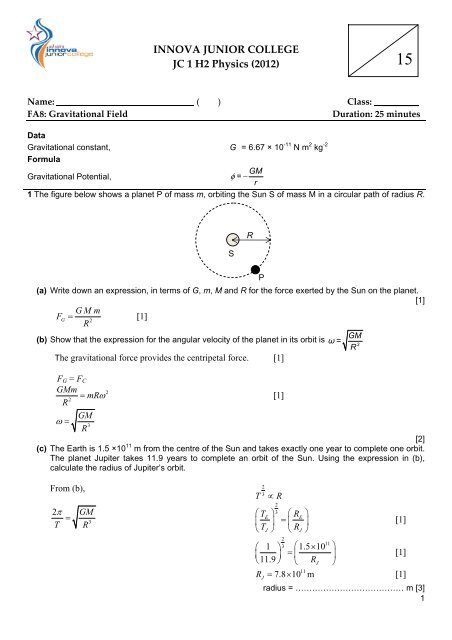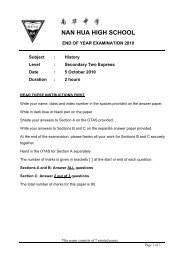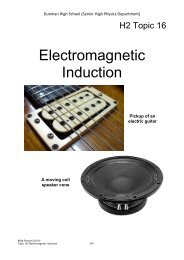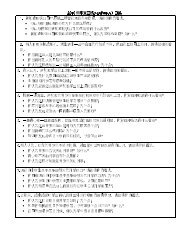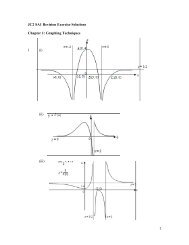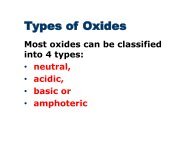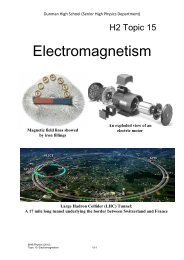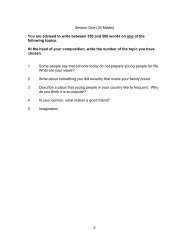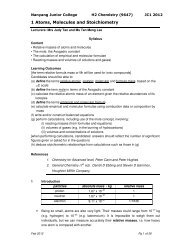INNOVA JUNIOR COLLEGE JC 1 H2 Physics (2012) - ASKnLearn
INNOVA JUNIOR COLLEGE JC 1 H2 Physics (2012) - ASKnLearn
INNOVA JUNIOR COLLEGE JC 1 H2 Physics (2012) - ASKnLearn
You also want an ePaper? Increase the reach of your titles
YUMPU automatically turns print PDFs into web optimized ePapers that Google loves.
<strong>INNOVA</strong> <strong>JUNIOR</strong> <strong>COLLEGE</strong><br />
<strong>JC</strong> 1 <strong>H2</strong> <strong>Physics</strong> (<strong>2012</strong>)<br />
15<br />
Name: ( ) Class: ________<br />
FA8: Gravitational Field<br />
Duration: 25 minutes<br />
Data<br />
Gravitational constant, G = 6.67 × 10 -11 N m 2 kg -2<br />
Formula<br />
Gravitational Potential, = GM<br />
r<br />
1 The figure below shows a planet P of mass m, orbiting the Sun S of mass M in a circular path of radius R.<br />
S<br />
R<br />
P<br />
(a) Write down an expression, in terms of G, m, M and R for the force exerted by the Sun on the planet.<br />
[1]<br />
GMm<br />
FG<br />
[1]<br />
2<br />
R<br />
GM<br />
(b) Show that the expression for the angular velocity of the planet in its orbit is ω =<br />
3<br />
R<br />
The gravitational force provides the centripetal force. [1]<br />
F G = F C<br />
GMm<br />
2<br />
<br />
2 mR <br />
[1]<br />
R<br />
GM<br />
<br />
3<br />
R<br />
[2]<br />
(c) The Earth is 1.5 ×10 11 m from the centre of the Sun and takes exactly one year to complete one orbit.<br />
The planet Jupiter takes 11.9 years to complete an orbit of the Sun. Using the expression in (b),<br />
calculate the radius of Jupiter’s orbit.<br />
2<br />
From (b),<br />
3<br />
T R<br />
2<br />
2 GM <br />
3<br />
T <br />
E<br />
R <br />
E<br />
3<br />
T R<br />
<br />
TJ<br />
RJ<br />
<br />
2<br />
3<br />
[1]<br />
11<br />
1 1.510<br />
<br />
<br />
11.9 RJ<br />
<br />
[1]<br />
11<br />
R 7.8 10 m<br />
[1]<br />
J<br />
radius = ………………………………… m [3]<br />
1
2 A satellite of mass 20 kg orbits the Earth with a uniform circular motion of period 24 hours, so that it is<br />
always directly above the same point on the Earth.<br />
(a) Explain why the orbit of the satellite must lie in the equatorial plane.<br />
The Earth is rotating from West to East about its axis. If it’s not placed at the equatorial plane, it will<br />
be sometimes over the northern or southern hemisphere [1] and hence not directly above the same<br />
point on the Earth.<br />
Or<br />
The gravitational force on the satellite acts towards the centre of the Earth. The satellite needs to be<br />
placed in a horizontal plane that cuts through the centre of the Earth and yet rotate in the same<br />
direction as the Earth’s [1], hence it has to be the equatorial plane.<br />
(b) Given that the gravitational field strength on the Earth’s surface is 9.81 m s -1 and the radius of the<br />
Earth is 6.4 ×10 6 m, calculate<br />
(i) the radius of the orbit<br />
F G = F C<br />
GMm 2<br />
<br />
<br />
2 mr <br />
r T <br />
2<br />
GM 2<br />
<br />
<br />
3 <br />
r T <br />
gr E<br />
3<br />
r<br />
2<br />
2<br />
<br />
<br />
T <br />
2<br />
6 2<br />
(9.81)(6.4 10 ) 2<br />
r<br />
3<br />
2<br />
<br />
<br />
246060<br />
<br />
2<br />
[1]<br />
[1]<br />
r = 4.2 × 10 7 m [1]<br />
radius = ………………………………… m [3]<br />
(ii)<br />
the satellite’s gravitational potential energy,<br />
U<br />
GMm<br />
<br />
r<br />
U<br />
gR m<br />
<br />
r<br />
(9.81)(6.410 ) (20)<br />
4.2 10<br />
[1]<br />
2 6 2<br />
E<br />
<br />
7<br />
U <br />
8<br />
1.91310 J<br />
U <br />
8<br />
1.910 J<br />
[1]<br />
gravitational potential energy = ………………………………… J [2]<br />
2
(ii) the satellite’s kinetic energy,<br />
GMm<br />
K <br />
2r<br />
2 6 2<br />
gRE<br />
m (9.81)(6.410 ) (20)<br />
K <br />
7<br />
2r<br />
2(4.2 10 )<br />
[1]<br />
7<br />
K 9.567<br />
10 J<br />
7<br />
K 9.6 10 J<br />
[1]<br />
kinetic energy = ………………………………… J [2]<br />
(iii) the satellite’s total energy.<br />
8 7<br />
E ( 1.91310 ) (9.56710 )<br />
T<br />
E <br />
T<br />
7<br />
9.610 J<br />
[1]<br />
total energy = ………………………………… J [1]<br />
END OF PAPER<br />
3


